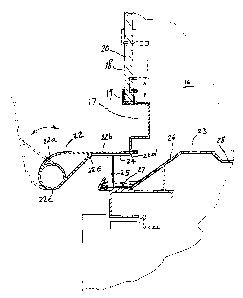Une partie des informations de ce site Web a été fournie par des sources externes. Le gouvernement du Canada n'assume aucune responsabilité concernant la précision, l'actualité ou la fiabilité des informations fournies par les sources externes. Les utilisateurs qui désirent employer cette information devraient consulter directement la source des informations. Le contenu fourni par les sources externes n'est pas assujetti aux exigences sur les langues officielles, la protection des renseignements personnels et l'accessibilité.
L'apparition de différences dans le texte et l'image des Revendications et de l'Abrégé dépend du moment auquel le document est publié. Les textes des Revendications et de l'Abrégé sont affichés :
| (12) Brevet: | (11) CA 2141356 |
|---|---|
| (54) Titre français: | HOTTE DE LABORATOIRE AVEC DEFLECTEUR D'AIR |
| (54) Titre anglais: | FUME HOOD WITH AIR FOIL MEMBER |
| Statut: | Durée expirée - au-delà du délai suivant l'octroi |
| (51) Classification internationale des brevets (CIB): |
|
|---|---|
| (72) Inventeurs : |
|
| (73) Titulaires : |
|
| (71) Demandeurs : |
|
| (74) Agent: | BORDEN LADNER GERVAIS LLP |
| (74) Co-agent: | |
| (45) Délivré: | 2006-03-07 |
| (22) Date de dépôt: | 1995-01-30 |
| (41) Mise à la disponibilité du public: | 1996-07-21 |
| Requête d'examen: | 2001-01-29 |
| Licence disponible: | S.O. |
| Cédé au domaine public: | S.O. |
| (25) Langue des documents déposés: | Anglais |
| Traité de coopération en matière de brevets (PCT): | Non |
|---|
| (30) Données de priorité de la demande: | ||||||
|---|---|---|---|---|---|---|
|
Une hotte de laboratoire comprend une base, des parois latérales et un couvercle qui définissent un espace de travail fermé, une surface de travail, et au moins une ouverture et une ouverture d'accès. La hotte de laboratoire comprend également un volet à guillotine pour fermer l'ouverture et un déflecteur d'air à proximité de la portion de rebord de l'ouverture pour diriger le courant d'air vers l'ouverture et dans l'espace de travail. Ce déflecteur d'air comporte une portion plate ayant une surface qui repose normalement à égalité avec la surface de travail de la hotte de laboratoire.
A fume hood includes a base, sidewalls and a cover that define an enclosed work space, a work surface, at least one trough, and an access opening. The fume hood also includes a moveable sash for closing the opening and an air foil disposed proximate an edge portion of the opening to direct air flow through the opening and into the work space. This air foil includes a flat portion with a surface that normally lies flush with the work surface of the fume hood.
Note : Les revendications sont présentées dans la langue officielle dans laquelle elles ont été soumises.
Note : Les descriptions sont présentées dans la langue officielle dans laquelle elles ont été soumises.

2024-08-01 : Dans le cadre de la transition vers les Brevets de nouvelle génération (BNG), la base de données sur les brevets canadiens (BDBC) contient désormais un Historique d'événement plus détaillé, qui reproduit le Journal des événements de notre nouvelle solution interne.
Veuillez noter que les événements débutant par « Inactive : » se réfèrent à des événements qui ne sont plus utilisés dans notre nouvelle solution interne.
Pour une meilleure compréhension de l'état de la demande ou brevet qui figure sur cette page, la rubrique Mise en garde , et les descriptions de Brevet , Historique d'événement , Taxes périodiques et Historique des paiements devraient être consultées.
| Description | Date |
|---|---|
| Inactive : Périmé (brevet - nouvelle loi) | 2015-01-30 |
| Inactive : TME en retard traitée | 2014-01-27 |
| Inactive : Lettre officielle | 2014-01-16 |
| Inactive : Paiement - Taxe insuffisante | 2014-01-15 |
| Lettre envoyée | 2013-01-30 |
| Inactive : CIB de MCD | 2006-03-11 |
| Accordé par délivrance | 2006-03-07 |
| Inactive : Page couverture publiée | 2006-03-06 |
| Préoctroi | 2005-11-14 |
| Inactive : Taxe finale reçue | 2005-11-14 |
| Un avis d'acceptation est envoyé | 2005-05-30 |
| Un avis d'acceptation est envoyé | 2005-05-30 |
| Lettre envoyée | 2005-05-30 |
| Inactive : Approuvée aux fins d'acceptation (AFA) | 2005-05-03 |
| Lettre envoyée | 2005-03-01 |
| Modification reçue - modification volontaire | 2004-05-19 |
| Inactive : Dem. de l'examinateur par.30(2) Règles | 2003-11-21 |
| Modification reçue - modification volontaire | 2002-04-05 |
| Inactive : Renseign. sur l'état - Complets dès date d'ent. journ. | 2002-02-25 |
| Lettre envoyée | 2002-02-25 |
| Inactive : Dem. traitée sur TS dès date d'ent. journal | 2002-02-25 |
| Toutes les exigences pour l'examen - jugée conforme | 2001-01-29 |
| Exigences pour une requête d'examen - jugée conforme | 2001-01-29 |
| Demande publiée (accessible au public) | 1996-07-21 |
Il n'y a pas d'historique d'abandonnement
Le dernier paiement a été reçu le 2005-12-15
Avis : Si le paiement en totalité n'a pas été reçu au plus tard à la date indiquée, une taxe supplémentaire peut être imposée, soit une des taxes suivantes :
Veuillez vous référer à la page web des taxes sur les brevets de l'OPIC pour voir tous les montants actuels des taxes.
Les titulaires actuels et antérieures au dossier sont affichés en ordre alphabétique.
| Titulaires actuels au dossier |
|---|
| FISHER HAMILTON SCIENTIFIC INC. |
| Titulaires antérieures au dossier |
|---|
| JOHN M. BASTIAN |